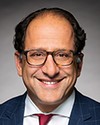Thank you, Mr. Chair and committee members.
I will make my remarks in English this morning to simplify interpretation. Afterwards, I will be able to answer questions in French, if the committee has any.
I would first like to acknowledge I am speaking today on the traditional and unceded lands of the Algonquin Anishinabe people.
Thank you for the invitation to appear before you, alongside my colleagues from the Canada Border Services Agency, Public Safety and the Privy Council Office, to speak about Canada-U.S. border management.
My name is Sean McGillis. I am the assistant deputy minister of federal policing strategy and business management. I am joined today by my colleagues Chief Superintendent McGowan from our federal policing border integrity program and Assistant Commissioner Santosuosso from our specialized policing services.
Border integrity is a shared priority for both Canada and the United States that requires strong co-operation between the RCMP and U.S. law enforcement agencies. Canada and the U.S. are contending with new threats to border security marked by global instability and shifting migration patterns, which are being exploited by organized crime groups. It is therefore essential that Canadian and U.S. law enforcement agencies maintain their collaborative and effective partnerships to preserve our shared border.
The RCMP works adeptly with its portfolio partners, law enforcement agencies and indigenous partners across the country to ensure operational readiness to address any border challenges.
The RCMP and the Canada Border Services Agency hold a shared responsibility for securing Canada's borders from inbound and outbound criminal threats. The CBSA manages the access of people and goods to and from Canada at our ports of entry, whereas the RCMP is responsible for securing our borders between the official ports of entry.
The RCMP's duties and authorities related to border security are identified in the RCMP Act and regulations, the Customs Act and the Immigration and Refugee Protection Act and regulations. The RCMP's federal policing program conducts investigations related to cross-border offences such as illegal entries; human, drug and firearm trafficking; and other illicit activities.
As you are aware, Bill C-2, the strong borders act, was introduced in the House of Commons by the Minister of Public Safety in May of this year. Bill C-2 represents the next step in Canada's border plan and proposes a suite of measures that will support three pillars.
The first is securing the border. This includes amendments to the Customs Act, the Oceans Act, the Immigration and Refugee Protection Act, the Department of Citizenship and Immigration Act and the Sex Offender Information Registration Act.
The second pillar is combatting transnational and organized crime and fentanyl. This includes amendments to the Controlled Drugs and Substances Act and the Criminal Code and introduces the supporting authorized access to information act.
The third is disrupting illicit financing. This includes amendments to the Proceeds of Crime (Money Laundering) and Terrorist Financing Act and the Office of the Superintendent of Financial Institutions Act.
In parallel, the RCMP continues to advance several initiatives under Canada's border plan as part of its commitment to detect, investigate and disrupt the most significant criminal threats to public safety in Canada.
The RCMP has deployed an aerial intelligence task force comprising helicopters, drones and mobile surveillance towers to monitor between the ports of entry and ensure rapid response to any border incidents.
The RCMP is also advancing efforts with U.S. partners to implement a North American joint strike force to target organized crime and the trafficking of precursor chemicals and illegal substances, including fentanyl. This initiative includes teams of law enforcement, border security and intelligence professionals across Canada and the United States. It will also involve new resources and frontline personnel, as well as technical operations capacity and infrastructure. The strike force complements and builds on existing operational efforts to tackle fentanyl across intelligence to criminal operations, both domestic and international, acting as a force multiplier.
Recognizing that money laundering underpins most criminal activity, including fentanyl trafficking, the integrated money laundering intelligence partnership was established in support of the permissible sharing of money laundering and organized crime intelligence between the RCMP and Canada's big banks.
In addition, the newly established joint operational intelligence cell is actively bringing together security agencies and key law enforcement partners to bolster the broader flow of intelligence on transnational organized crime and fentanyl.
To conclude, the current global landscape pushes us to recognize that border management is not simply about managing the movement of people or goods across the border. It's about ensuring that law enforcement has the right tools to keep our borders secure, combat transnational organized crime and stop the flow of illegal fentanyl.
Thank you for the opportunity to speak to you today. I look forward to discussing Canada-U.S. border management.
My colleagues and I will be pleased to take any questions you may have.
Thank you, Mr. Chair.










